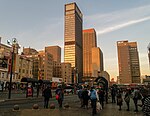Carlton Hotel (Johannesburg)
1972 establishments in South Africa1998 disestablishments in South AfricaAccuracy disputes from March 2022Defunct hotelsHotel buildings completed in 1972 ... and 5 more
Hotels disestablished in 1998Hotels established in 1972Skidmore, Owings & Merrill buildingsSkyscraper hotelsSkyscrapers in Johannesburg

The Carlton Hotel is a historic hotel in the Central Business District of Johannesburg, South Africa. It opened in 1972 as part of the enormous Carlton Centre complex, and has been closed since 1998. Its closure has been attributed to the decay of the Central Business District, resulting in a severe crime wave and the flight of the city's corporate offices north to areas like Sandton and Rosebank. This created a plethora of vacant rooms that were unable to be filled. The main hotel tower was closed in December 1997.
Excerpt from the Wikipedia article Carlton Hotel (Johannesburg) (License: CC BY-SA 3.0, Authors, Images).Carlton Hotel (Johannesburg)
Smal Street, Johannesburg Johannesburg Ward 124
Geographical coordinates (GPS) Address External links Nearby Places Show on map
Geographical coordinates (GPS)
| Latitude | Longitude |
|---|---|
| N -26.206111111111 ° | E 28.046388888889 ° |
Address
Carlton Hotel
Smal Street
2001 Johannesburg, Johannesburg Ward 124
Gauteng, South Africa
Open on Google Maps









